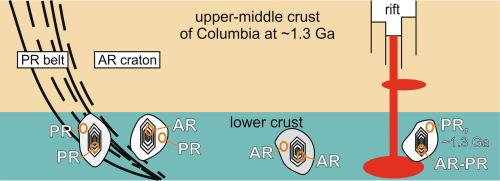Gondwana Research ( IF 6.1 ) Pub Date : 2021-04-23 , DOI: 10.1016/j.gr.2021.02.024 Marina Koreshkova , Hilary Downes

|
We have compiled data on textures, trace element contents, Hf isotope compositions and U-Pb ages of zircons from lower crustal xenoliths from the central part of the Columbia supercontinent in Precambrian areas in North America, Siberia and Northern Europe to address the question of when the host rocks to the zircons became part of the lower continental crust. The time when the lower crust reached its current state, a layer of high-pressure granulite-facies rocks, is dated by zircons that have equilibrated with the observed metamorphic association. Magmatic zircons can provide the age of protolith crystallization, which did not necessarily occur within the lower crust. Those from within Archean cratonic areas of Columbia (the Slave, Wyoming, Superior, Siberian and Karelian cratons and the Archean Belomorian mobile belt in NW Russia) yield predominantly Archean ages (3.5–2.6 Ga). Addition of Proterozoic material is rarely recorded in dated magmatic zircons (2.50–2.47 and 1.64 Ga). The granulite-facies association formed in Archean times has been preserved in lower crustal rocks of the Slave and Superior cratons despite later re-heating events. In other Archean areas of Columbia, the lower crust was reworked during Paleoproterozoic orogenic events. At present, 1.9–1.7 Ga old granulitic lower crust predominates, formed during the assembly of the Columbia supercontinent. Nevertheless, sporadic surviving metamorphic zircons show that Archean lower crustal remnants are occasionally preserved. Mesoproterozoic and younger extensional events and anorogenic magmatism occurred across a wide area at the southern margins of the Superior and Wyoming cratons, in the Belomorian belt, Yavapai and Mazatzal provinces and the Cheyenne belt. These events caused significant reworking of the lower crust with migmatization and formation of the granulite-facies association. The main differences of upper and lower crustal metamorphic histories are slow cooling and long duration of thermal events in the lower crust.
中文翻译:

哥伦比亚超大陆中部下部地壳的年龄:锆石数据的回顾
我们收集了来自北美,西伯利亚和北欧前寒武纪地区哥伦比亚超大陆中部下部地壳异种岩的质地,痕量元素含量,Hf同位素组成和锆石的U-Pb年龄的数据,以解决何时出现的问题锆石的主体岩石成为下部大陆壳的一部分。下地壳达到其当前状态的时间是一层高压花岗石相岩石,其形成时间与已观测到的变质作用相平衡的锆石有关。岩浆锆石可以提供原生岩结晶的年龄,而不一定在下地壳内发生。那些来自哥伦比亚太古宙克拉通地区(奴隶,怀俄明州,苏必利尔州,西伯利亚克拉通和卡雷利亚克拉通以及俄罗斯西北部的太古代贝洛莫里亚移动带主要产生太古代时代(3.5–2.6 Ga)。过时的岩浆锆石(2.50–2.47和1.64 Ga)中很少记录到元古代物质的添加。尽管后来发生了再加热事件,但在太古时代形成的花岗石-岩相组合一直保留在从属和上等克拉通的下地壳岩石中。在哥伦比亚的其他太古代地区,在古元古代造山事件中对下地壳进行了改造。目前,在哥伦比亚超大陆的组装过程中,形成了1.9–1.7 Ga的老粒状下地壳。然而,零星尚存的变质锆石表明,太古宙下部地壳残留物偶尔得以保存。中上生界和较年轻的伸展活动和成因岩浆活动发生在上,下和怀俄明克拉通的南部边缘,贝洛莫里山带,亚瓦派和马萨尔察尔省和夏安带。这些事件导致下地壳大量返工,发生了迁移作用,并形成了花岗石相相。上地壳和下地壳变质历史的主要区别是下地壳的缓慢冷却和热事件持续时间长。


























 京公网安备 11010802027423号
京公网安备 11010802027423号